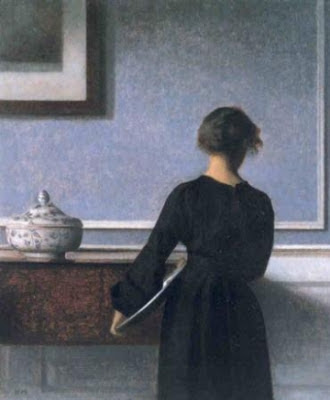 |
| detail, Hammershøi: Young Woman from Behind |
Never mind that the third series does not, and never could, match up, that the supporting characters are less profoundly observed and the interlocking plots more formulaic. With a sense of duty that matches Lund's, Sofie Gråbøl.....CONTINUED
has sustained the integrity and subtlety of her acting, even in her guest appearance in Eddie's dream in Absolutely Fabulous. The spoof kept respect because it contained a universal truth: like Eddie, thousands of us were struggling at the time to learn a few basic Danish words so we could immerse ourselves in Lund's world. She is so real to us, in her frailties as much as her strengths, her transparent honesty so reassuring, her mistakes so forgiveable, that we want to befriend her.
One of her male TV counterparts is Jack Bauer, who grown men and women addicted to 24 treated as their best friend, but though as driven, she's more down-to-earth, less politically dodgy and even more reserved. Intuitive and physically brave as the other great female detectives and PIs, she seems lonelier than any of them, more dogged and taciturn, and she has less fun, true to the tradition of Nordic mythology where females never had the autonomy of Mediterranean and Middle Eastern goddesses. She believes in her abilities as a detective, has no belief in authority, an irrelevance to her, getting in the way of the truth the same way that family ties do, she is stubborn and insubordinate, but she has no personal confidence at all. Like Cassandra, she is not believed. Her isolation has a lot in common with weathered literary detectives, like Bosch and Renko (not a synthetic avatar like Jack Reacher, 6'5" blond, broad-chested, ice-blue-eyed Aryan destined to be reconstructed inside Tom Cruise).
Unlike even the loneliest and grumpiest of her male contemporaries, Lund is not comforted by casual sexual relationships. Whenever she feels powerfully connected to a man, intimacy puts the huntress off the scent. Like the Virgin Queen, she must deny herself love if she is to fulfill her duty. When, at the start of the final series, she tries to settle for normal middle-aged life, a cushier job with a pension, a family supper with the son she loves but has never mothered, she is pulled back to the gory trail by her calling, like a reluctant valkyrie riding into battle to choose who must die.
She bears as much or more pain than a man without complaint, but has to suffer the stigmatization of bad mother as well. Hedda Gabler, while envying female independence from patriarchy, would have recognized the inhospitable post-feminist society that Lund inhabits. None of her male colleagues care that she is at the end of her tether. Nobody indulges her; they expect and demand. When she tries to break down unobserved, she's allowed two hesitant, inexperienced sobs before she's ordered back to work.
Not since Hamlet's prison has Denmark been such a potent metaphor of contemporary states of mind and nation. Couples, families, businesses and political groups are split by duplicity and betrayal. Abducted and murdered children haunt the dying northern world. The most virtuous people are compromised or sick of themselves. No-one in Forbrydelsen is ever completely bad (except the State's internal affairs inquisitors, maybe) or completely happy. They never fully understand or possess another person. While other popular TV culture feeds our sugar-lust with a pre-nuptial kiss or the titillating violence of a reality show bust-up, Forbrydelsen serves up existential hopelessness, grey and dry without the colourful depravity of Engrenages, tauter than Wallander, the Scandi-noir gloom lit by wry humour and endearing quirks of character.
Every killing is a broken trust. Just when we think we've found a sexy, witty and reliable man to console our heroine (2nd series), eyes twinkling cutely under his shaved head, he melts into a murderous liar without a word of recrimination passing between them; or when she meets the love of her youth again, it's too late, she's battle-weary, in retreat, suspicious of everybody, he's at first censorious of what she has become, he's married to someone else, and has secrets of his own. (3rd series).
Sofie Gråbøl has compared the character she plays to Clint Eastwood's film persona, always going into the sunset alone, uncomplaining, expecting forgiveness from no-one. In Lund's dangerous professional and ascetic private life, western cowboy meets Jane Austen heroine, in the gun-slinging, self-denying quest for truth in an indifferent world.
Interior with Young Woman from Behind, oil on canvas, 1904, by Vilhelm Hammershøi (1864-1916).
Randers Kunstmuseum, Denmark. Image source:Wikipedia
